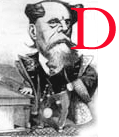 ickens made extensive use of Shakespeare's tragic drama King Lear throughout his novels, beginning with Dombey and Son, but according to Alexander Welsh, Little
Dorrit contains the novelist's "most deeply felt response to the play."
ickens made extensive use of Shakespeare's tragic drama King Lear throughout his novels, beginning with Dombey and Son, but according to Alexander Welsh, Little
Dorrit contains the novelist's "most deeply felt response to the play."
The project of Little Dorrit was to be less straightforward than that of Dombey and not finally tragic. Rather, Dickens would superimpose upon his great Lear figure, the Father of the Marshalsea and the father of Little Dorrit, his middle-aged hero and husband of Little Dorrit — a project so ambitious that it is scarcely more than hinted at by David Copperfield's replacement of the father in Agnes Wickfield's life. In Little Dorrit, too, the Cordelia figure would come decisively into the foreground, in the title as well as the action of the novel. . . . His interest in pursuing the story was still strong in A Tale of Two Cities, in the relation of Lucy and Dr. Manette.
Dickens, Welsh points out, was somewhat unusual in preferring this particular Shakespearean tragedy to the more popular Hamlet, and he therefore asks "why the novelist passed by, or occasionally made fun of, Hamlet, the play most widely regarded in the nineteenth century as Shakespeare's greatest, and responded so fully to Lear, the play that has dominated the canon and tried our consciences in the second half of the twentieth century." He concludes that Dickens found Lear's central themes far more compelling than those involved in the tragedy of the Prionce of Denmark: "Dickens was more concerned throughout his writings with the collapse of authority through approaching death, imagined from the point of view of the dying, than with a restoration of power consumed by mourning for the dead. He was, I believe, prematurely concerned with his own death" (104).
References
Welsh, Alexander. Dickens and Copyright.
Last modified 24 October 2002